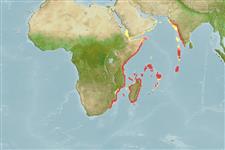Environment: milieu / climate zone / depth range / distribution range
Ekologi
laut dasar (demersal); kisaran kedalaman 20 - 406 m (Ref. 51668). Tropical; 23°N - 30°S, 30°E - 80°E
Western Indian Ocean: Natal, South Africa to India.
Size / Weight / umur
Maturity: Lm ? range ? - ? cm
Max length : 19.0 cm TL jantan/; (Ref. 6270)
Duri punggung (Keseluruhan (total)): 0; duri punggung lunak (Keseluruhan (total)): 55-60; Duri dubur 0; Sirip dubur lunak: 46 - 49. Eyed side dark brown, with black spots and blotches forming vague crossbars; dark bar on at caudal fin base; blind side dark brown; round black spots on head (Ref. 6270).
Life cycle and mating behavior
Kematangan | Reproduksi, perkembang biakan | Pemijahan | telur-telur | Fecundity | Larva
Heemstra, P.C., 1986. Pleuronectidae. p. 863-865. In M.M. Smith and P.C. Heemstra (eds.) Smith's sea fishes. Springer-Verlag, Berlin. (Ref. 6270)
Status IUCN Red List (Ref. 130435)
ancaman kepada manusia
Harmless
penggunaan manusia
informasi lanjut
Nama-nama umumSinonim (persamaan)metabolismePemangsaEkotoksikologiReproduksi, perkembang biakanKematanganPemijahanSpawning aggregationFecunditytelur-telurpekembangan telor
Umur / SaizPertumbuhanpanjang-beratpanjang-panjangukuran frekuensiMorfometrikMorfologiLarvaDinamika larvapemulihanKelimpahanBRUVS
AcuanBudidaya airprofil budidaya airStrainGenetikaElectrophoresesDiturunkanPenyakit-penyakitPengolahanNutrientsMass conversion
mitraGambarStamps, Coins Misc.Suara-suaraCiguateraKecepatanTipe renangArea insangOtolithsOtakPenglihatan / visi
Alat, peralatan
laporan khas
muat turun XML
Sumber internet
Estimates based on models
Preferred temperature (Ref.
123201): 15.8 - 25.3, mean 21.4 °C (based on 65 cells).
Phylogenetic diversity index (Ref.
82804): PD
50 = 0.7500 [Uniqueness, from 0.5 = low to 2.0 = high].
Bayesian length-weight: a=0.01995 (0.00906 - 0.04395), b=3.01 (2.83 - 3.19), in cm total length, based on all LWR estimates for this body shape (Ref.
93245).
Trophic level (Ref.
69278): 3.6 ±0.4 se; based on size and trophs of closest relatives
Fishing Vulnerability (Ref.
59153): Low vulnerability (10 of 100).
